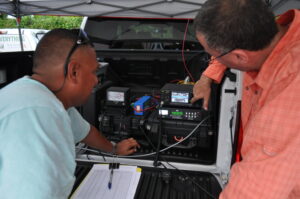
The Amateur Radio Service (amateur radio or ham radio) is a wide range of frequencies allocated by the FCC for hobbyist use. Amateur radio frequencies are spread over a huge range from just below the AM broadcast band to microwave frequencies. Communications can be via voice, data, Morse code, or video.
Amateur radio hobbyists must pass a technical test in order to obtain a license. There are 3 license classes, each providing it’s holder with additional privileges as they progress up the license ladder. Morse code proficiency is no longer required to obtain an amateur radio license. The three license classes are Technician, General, and Extra class. You start with the Technician class and work your way up (if you want to). You don’t need to progress through the ranks unless you want access to the additional frequencies each license grants you.
Unlike any other radio service, amateur radio operators are not only allowed, but encouraged to experiment with antennas and equipment. Hams can typically operate at power levels in excess of 1,000 watts with few exceptions. Equipment can be portable, mobile, or base. Amateur radio operators have historically been known to be the first to establish communications into disaster stricken areas.
There’s plenty of information on the hobby scattered all over the internet, some of it is well written, some is not that great. If you’re interested in learning more about the hobby via a Wikipedia format, follow the link below.
https://en.wikipedia.org/wiki/Amateur_radio
For information on getting your amateur license, follow the link below.
http://www.arrl.org/licensing-education-training
The ARRL is a national organization that supports amateur radio but their method of study for getting a ham license may not work/appeal to all. If you’re already a techie and prefer to learn as you go but need to get your “foot in the door” there’s another way to study for the test. You can hit the ground running taking practice tests and memorize the answers until you consistently achieve passing scores. If this method works for you, follow the link below.
Hamstudy lets you take the practice tests over and over as many times as you want and tells you how you’re doing as you go along. It tells you which you got wrong and even gives you a brief explanation of the correct answer. This is the unconventional way of learning the material but the decision of which way to learn is up to you and nobody else.
I personally learn by doing so I found the ARRL method to be as mind numbing as reading a book about a computer language. I used a method similar to the Hamstudy website and then read up on things that interested me further as I got into the hobby. It worked, I currently hold a general class license.
So you’ve been studying and you’re ready to take the test? First you’ll need an FRN number from the FCC. If you have an FCC license of any kind, you already have an FRN. If you don’t already have one, register with the FCC and get your FRN number. Follow the link below to register for an FRN.
Once you have an FRN, test sessions can be found by following the link below. There is a fee associated with taking your ham test so be sure to confirm what it is and what methods of payment are accepted BEFORE you go take your test.